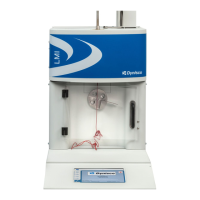providing a window into the process
Use gloves--it's very HOT!
To p
revent burns, gloves and a long sleeve shirt (or lab coat) are essential. Dies and piston rods
are extremely hot and are designed to quickly transfer heat to the sample being tested.
Unfortunately this means they will transfer heat very quickly to you as well. Even brief contact
with a hot item can cause a burn. The indexer barrel housing can also get fairly hot. However, at
any barrel temperature, these should not cause burns if touched for a very brief period except
very near the barrel top and bottom. Consider where dies may fall. If they are dropped on Nylon
carpeting or similar materials they can quickly form holes. Protective mats may be needed.
DYNISCO POLYMER TEST recommends keeping hot piston rod and hot die in the
chamber/barrel; this precludes someone picking it up inadvertently. Be sure to hold
the piston
by the top insulator.
Electrical Hazard
Your
Dynisco Lab Melt Flow Indexer contains high voltage inside the housing. DO NOT remove
the housing or any part of its outer covers; there are no user serviceable parts inside. Service
should only be done by a qualified DYNISCO Service Technician. Be sure the outlet used to
power the indexer is properly grounded.
Calibration Thermometers may use Mercury
To calibrate the temperature on the indexer, a thermometer containing about 8 grams of
mercury may be used. Every lab with mercury thermometers or equipment containing mercury
must be prepared for breakage. Note that mercury exposed to air “evaporates” at room
temperature, producing an invisible, tasteless, odorless and dangerous vapor. Thermometers
have been used for decades in laboratory equipment and when used properly provide an
accurate and effective means of calibration. Keep the thermometer in a safe place where it will
not be crushed or otherwise broken. When using the thermometer be careful not to drop or
bend the glass. Place a hot thermometer onto cotton patches to cool. Never put a hot
thermometer in contact with cold metal or cold solvent because the thermal shock can crack or
shatter the glass. Mercury is extremely toxic and should be handled accordingly.
A material safety data sheet (MSDS) for mercury (Hg) can be found on the Internet. Observe
local, state and federal hazardous waste disposal laws when disposing of any broken
thermometers. If packaged in a sealed plastic container and labeled with the following symbol:
P/N: M0726(3) | Rev: 012020 | ECO: 51182
www.dynisco.com

